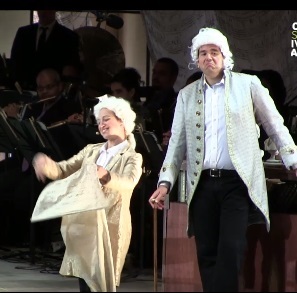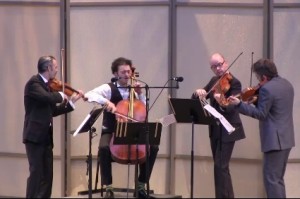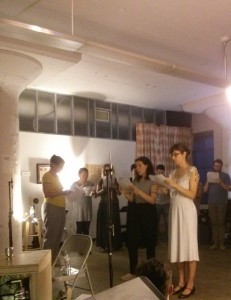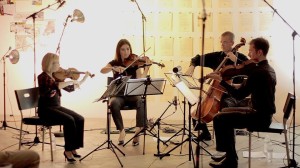Not only is it hard to describe Benedict Mason’s Meld, which was given it’s first performance on the late night Prom given by the Aurora Orchestra and the choral group Chantage, conducted by Nicholas Collon, on August 16, it’s hard even beginning to think about how to describe it. All of the advance notices of the concert were particularly, and unusually, vague about the details of the work, and even the program claimed to be not at liberty to divulge much information about it. In the concert itself, which began with the Mozart 40th Symphony (played from memory) and also included Dobrinka Tabakova’s Spinning a Yarn, a short and very attractive piece for violin and hurdy-gurdy, played (also from memory) from the organ loft by Alexandra Wood and Stevie Wishart, the fact that something was up was indicated by the emptiness of the arena and gallery of the Albert Hall, the domain of the promenaders. One noticed a number of people who are continually there as promenaders in very good seats in the stalls.
Once it was underway it was clear that Meld was going to use all of the Albert Hall, up, down, inside, and out. It began with a mysterious and halting throbbing music coming from some place outside of the hall which turned into a march for a parade of players across the gallery at the top of the hall. Suddenly there were four bass players in the lower tier of boxes, echoing a group of ‘cellos and basses in the gallery, and then, suddenly without one having noticed their getting there at all, the entire upper tier of boxes was filled with pairs of players and singers, who sent volleys of pizzicato notes ricocheting around the hall, succeeded by skittering and scurrying flurries of notes. After a period of time when different kinds of groups with different instrumentation would seem to simply appear in lots of different places, a bevy of horns started moving over the arena area and the stage, and eventually through the audience, followed by other people, playing various percussion instruments, sometimes moving very fast, pursuing, as the poet says, urgent voluntary errands. Then there were some small groups of players in the arena, seemingly menaced (I’m not sure if there’s another word for it) by one or two people wearing some kind of stoles of clacking blocks. The sequence of events is somewhat hazy in the memory, although the events themselves were striking and memorable. During all of this, the music–the actual notes being played–which had a fairly high level of complexity, was always full of detail and held one’s interest.
After a while the delight and excitement about what would happen next began to ebb somewhat, but not so much that anything ever got, for lack of a better word, boring. I found myself, though, wondering about what the shape of the piece being presented in this all enveloping environment and its structural argument might be. I was reminded of a place in the final scene of The Years by Virginia Woolf where one of the characters asks herself whether, if one could get far enough above life, one might be able to see a pattern in it. After a while longer I found myself thinking of another Woolf and wondering if Meld wasn’t a pageant, in some ways like the pageant in Between the Acts, including in its outlining some kind of (unspecified–in the case of the Mason) loosely historical progression. Pageants are a series of more or less static and not necessarily closely connected tableaux whose larger scale succession, thematic in some way, but not plot based, rather than the immediate flow of the individual moments give the work’s structure and continuity. At some points in Meld we seemed to be in fact offered some kind of excerpts of a pageant, in the bit with the clacking stoles, and also in a segment where most of the chorus and some players coalesced in the arena, first rolling balls of some kind and appearing to play some kind of game (cricket?), then formed several small groups doing what appeared to be some kind of folk dancing, and then made one big ring around the perimeter, before forming two groups that then sat for a few moments in seats in opposite sides of the stalls, muttering. At a certain point one began to wonder when and how it was all going to end, and eventually it did, but I can’t remember how, although I think it was more with a whimper than a bang.
There was never any point in this almost hour long work which was not engaging or at which the material, musical or otherwise, seemed anything less than first class. The performance, by 93 players and 49 singers, was astounding–completely committed and assured. They were playing without music, although everybody seemed to have receivers and earphones, and some of them seemed to be wearing cameras, so its hard to know exactly what information they were getting from that. The program listed a person responsible for staging and choreography (Mason), a movement director (Chris Tutor), and two people who did a click-track (Felix Bastian Dreher and Griff Hewis). The work involved in planning and executing the whole effort must have been mammoth, and it was brilliantly accomplished.
The recording of this Prom is available at http://www.bbc.co.uk/programmes/b04dqbhv.




